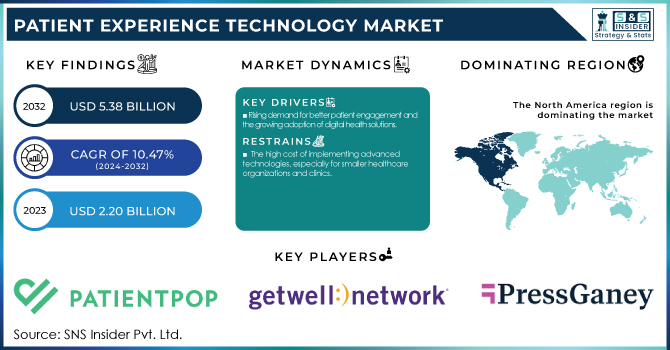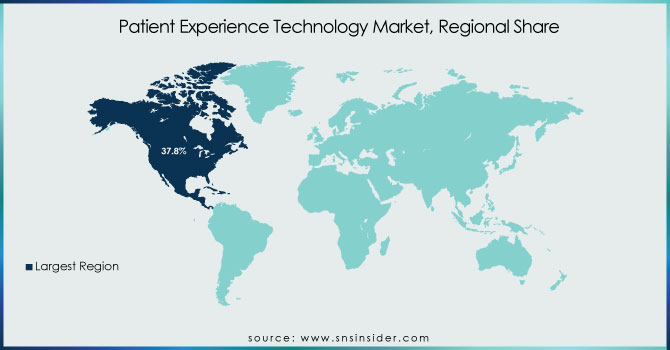Patient Experience Technology Market Size & Overview:
The Patient Experience Technology Market was valued at USD 2.20 billion in 2023 and is expected to reach USD 5.38 billion by 2032 and grow at a CAGR of 10.47% over the forecast period 2024-2032. This report examines regional trends in technology usage and adoption, focusing on how different regions are embracing digital health solutions. The study highlights the growing emphasis on patient-centered care models, with technology playing a crucial role in improving patient engagement and outcomes. It also explores investment trends in patient experience technologies, particularly the rising adoption by healthcare providers seeking to enhance their services. Furthermore, the report addresses the increasing usage of remote monitoring and wearable devices, which are transforming healthcare delivery by providing real-time data and improving the overall patient experience.

Get more information on Patient Experience Technology Market - Request Sample Report
Patient Experience Technology Market Dynamics:
Drivers
-
Rising demand for better patient engagement and the growing adoption of digital health solutions.
The growing demand for patient satisfaction and personalized care is pushing the trends for technologies in patient engagement platforms, telemedicine, and real-time feedback tools. The movement to value-based care, where patient outcomes and experience are key drivers, also propels healthcare systems toward solutions that offer improvements in communication, wait times, and care delivery processes. Government initiatives, including financial incentives for adopting electronic health records (EHRs) and telehealth, are fueling market growth. In addition, advancements in artificial intelligence (AI) and machine learning (ML) have improved the effectiveness of patient experience technologies, providing healthcare providers with actionable insights to enhance care outcomes.
Restraints
-
The high cost of implementing advanced technologies, especially for smaller healthcare organizations and clinics.
The initial investment in digital health solutions, such as telemedicine infrastructure, patient portals, and analytics platforms, can be a significant barrier for some providers. Integrating new technologies with legacy systems is also challenging for healthcare providers, which may deter the adoption of patient experience technologies. Data security and privacy concerns are also a significant barrier, as patients and healthcare organizations are cautious about potential breaches of sensitive health information. Regulatory complexity adds to this lag, especially when standards like HIPAA and GDPR are to be implemented. Moreover, the hesitance of various healthcare professionals as well as the patients towards introducing new digital means of solution building due to confusion or ineffectiveness in practice further constrains the market from expanding.
Opportunities
-
Advancing Predictive Analytics, Personalized Treatments, and Engagement Through Technology
AI and machine learning offer immense scope for the upgradation of patient care through predictive analytics, personalized treatment plans, and automated support. Continued progress in the development of virtual assistants and chatbots powered by AI will continue to improve the engagement of patients and support care teams in delivering more efficient services. Increased remote monitoring and telehealth also expand access to care. Beyond that, healthcare providers can look at new business models, such as subscription services or collaborations with tech vendors, to further streamline patient engagement and elevate the overall experience. As digital transformation continues, these innovations are set to define the future of patient care.
Challenges
-
One of the key challenges is interoperability ensuring seamless communication and data sharing across various systems
Most healthcare systems continue with legacy technologies, which are not integrated well with modern digital tools. Others face the slow adoption of digital services by patients: it is true that certain groups of patients, especially older adults, lack familiarity with applications such as telehealth or patient portals. Concerns about data privacy and security represent another big challenge because healthcare data is very sensitive and regulated. Highly technological systems are, therefore, limited in adoption. Small and resource-poor healthcare organizations lack the capability and resources to maintain such expensive technology. There are also additional costs and complexity for regulatory compliance requirements, especially when it comes to data protection regulations.
Patient Experience Technology Market Segmentation Insights:
By Component
In 2023, the segment that captured the most share was the software segment within the patient experience technology market. Software solutions, including patient engagement platforms, telehealth applications, and patient feedback analytics tools, are increasingly being used by healthcare providers to enhance the patient experience, improve workflow efficiency, and also enhance the patients' outcomes. This is driven by the increasing need for comprehensive solutions that allow for interoperable communication, updates in real-time, and tailored care experiences. Software allows for efficient management of patient data, and advanced analytics for insights, and can support remote care through telemedicine and virtual consultations. With the advancing applications of AI and ML, solutions in software technologies are increasingly upgrading to be the most efficient platforms for advanced tools in predictive analytics and decision-making. The growth is expected in patient engagement software because of increasing attention to enabling patients to manage their health. There is increasing adoption of mobile health apps, patient portals, and communication platforms that promote continuous engagement. The growing use of these applications, as well as other communication tools, is accelerating this growth, with healthcare systems adopting such software to improve patient satisfaction and enhance compliance with care.
By Application
Patient Feedback and Analytics emerged as the dominated segment in 2023. Due to the application meets the needs of the healthcare provider to gauge patient satisfaction, improve care quality, and optimize operational efficiency. With the application's capability to collect, analyze, and act on patient feedback, it has become a key tool for healthcare organizations looking to improve service offerings or otherwise respond effectively to patient concerns. Patient feedback tools are used by healthcare providers as actionable insights for refining the delivery of care, identifying service gaps, and improving the overall patient experience. Because the healthcare industry is increasingly becoming patient-centered, the role of feedback and analytics will continue to increase in significance.
Patient Engagement will grow at the fastest pace. The purpose of increasing involvement in their plans of care remains a primary drive for healthcare service providers to develop digital tools such as better communications, reminders of appointments, and educational resources to engage patients more actively. Among other factors for the rapid growth of patient engagement solutions, significant is the upsurge of chronic disease management and the enhanced requirement for monitoring patients remotely.
By Deployment Mode
The cloud-based deployment mode held the highest market share in 2023 and will continue to do so in the patient experience technology market during the forecast period. Cloud-based solutions offer a host of benefits that include cost-effectiveness, scalability, and flexibility, making it an attractive solution for healthcare providers. These solutions allow healthcare organizations to store and access patient data securely from any location and are ideal for telemedicine, remote patient monitoring, and patient engagement platforms. Moreover, a cloud-based model will ensure easy integration of different healthcare systems, improving interoperability and thus making all relevant patient information accessible in real-time. The on-premises deployment is expected to be the fastest-growing segment as healthcare facilities demand more control over their data and systems, particularly in regions that have stringent data protection regulations. Some healthcare providers prefer on-premises solutions due to data security concerns, regulatory compliance, and control over sensitive patient information.
By End User
In 2023, the largest market share in the patient experience technology market was held by hospitals, accounting for more than 50% of the revenue generated globally. Hospitals are the primary healthcare providers that use a wide range of patient experience technologies, including patient engagement platforms, telehealth solutions, and feedback analytics tools, to improve the quality of care and ensure a positive patient experience. With the emphasis placed on patient-centered care, hospitals prefer technologies that help streamline communication, not wait, and enhance overall service delivery. Clinics will see considerable growth in the coming years, as patient experience technology, such as appointment scheduling systems and online patient access, like portals and telehealth solutions, is fast growing. Small health providers seek cost-effective and efficient ways to improve patient care, and there's more tendency among clinics to embrace technologies that improve patient satisfaction and make administrative work easier.
Patient Experience Technology Market Regional Analysis:
North America dominated the market in 2023 with a 37.8% share due to the high adoption of digital health technologies, especially in the United States. The region benefits from a well-established healthcare system, increased government initiatives supporting digital health, and a large healthcare IT market. Healthcare providers in the U.S. and Canada are quickly embracing patient experience technologies like telehealth, patient portals, and AI-driven analytics to transform the way care is delivered and improve patient satisfaction. In addition, chronic diseases are widespread, and value-based care is on the rise, which drives regional sustained growth.
Europe closely followed as technological advancements and growing patient-centered care played a significant role. UK, Germany, and France even deeply invest in patient experience solutions, such as telemedicine and feedback systems from patients. Data privacy regulation by the European Union on GDPR further fuels market growth.
The Asia-Pacific region is expected to grow the fastest. Healthcare infrastructure in countries like China, India, and Japan is expanding rapidly, which drives demand for patient experience technologies, such as remote monitoring and patient engagement platforms, especially given a rapidly aging population and growing healthcare needs.

Need any customization research on Patient Experience Technology Market - Enquiry Now
Key Players:
-
PatientPop - PatientPop Platform
-
GetWellNetwork - GetWellNetwork Patient Engagement Solution
-
Press Ganey - Press Ganey Patient Experience Solutions
-
InCrowd - Patient and Provider Experience Insights
-
Solutionreach - Patient Relationship Management (PRM) Platform
-
SurveyMonkey - SurveyMonkey for Healthcare
-
naviHealth - naviHealth Post-Acute Care Solutions
-
Dimensional Insight - Diver Platform (Healthcare Analytics)
-
WELL Health Technologies - WELL Health Communication Platform
-
Verint Systems - Verint Customer Engagement Solutions
-
DrChrono - DrChrono EHR, Patient Portal
-
Lyniate - Lyniate Data Integration Solutions
-
Wolters Kluwer Health - UpToDate, Lexicomp
-
Qualtrics - Qualtrics Patient Experience Platform
-
1upHealth - 1upHealth API Platform
Recent Developments:
-
In Feb 2025, Press Ganey partnered with Microsoft to develop a suite of generative AI-powered solutions aimed at transforming healthcare. This collaboration focuses on providing actionable insights that will enhance safety, quality, and the overall patient experience in care delivery.
| Report Attributes | Details |
|---|---|
|
Market Size in 2023 |
USD 2.20 billion |
|
Market Size by 2032 |
USD 5.38 billion |
|
CAGR |
CAGR of 10.47% From 2024 to 2032 |
|
Base Year |
2023 |
|
Forecast Period |
2024-2032 |
|
Historical Data |
2020-2022 |
|
Report Scope & Coverage |
Market Size, Segments Analysis, Competitive Landscape, Regional Analysis, DROC & SWOT Analysis, Forecast Outlook |
|
Key Segments |
• By Component [Software, Services] |
|
Regional Analysis/Coverage |
North America (US, Canada, Mexico), Europe (Eastern Europe [Poland, Romania, Hungary, Turkey, Rest of Eastern Europe] Western Europe] Germany, France, UK, Italy, Spain, Netherlands, Switzerland, Austria, Rest of Western Europe]), Asia Pacific (China, India, Japan, South Korea, Vietnam, Singapore, Australia, Rest of Asia Pacific), Middle East & Africa (Middle East [UAE, Egypt, Saudi Arabia, Qatar, Rest of Middle East], Africa [Nigeria, South Africa, Rest of Africa], Latin America (Brazil, Argentina, Colombia, Rest of Latin America) |
|
Company Profiles |
PatientPop, GetWellNetwork, Press Ganey, InCrowd, Solutionreach, SurveyMonkey, naviHealth, Dimensional Insight, WELL Health Technologies, Verint Systems, DrChrono, Lyniate, Wolters Kluwer Health, Qualtrics, 1upHealth. |

